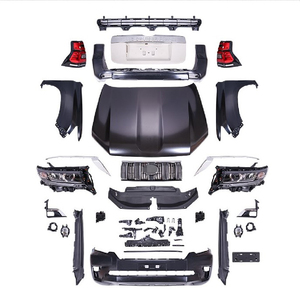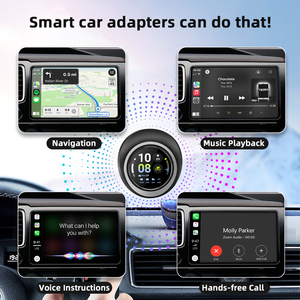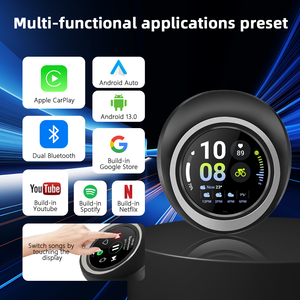Types of Android Auto Adapters
An Android Auto adapter makes it possible to connect a car's display to an Android device. The device offers access to GPS navigation, music streaming, and communication apps. There are two main types of Android Auto adapters that business buyers need to be aware of:
Wireless Android Auto Adapter
The wireless Android Auto adapter enables users to connect their Android devices to the car's display without any cables. It uses a secure Wi-Fi connection to facilitate data transfer.
With this feature, users can access maps, music, and messages just by tapping on the display or using their voices. They won't have to worry about fumbling with their phones while driving.
Key benefit: Hands-free, safe, and convenient way to stay connected on the road.
Notable Features:
- Enables wireless Android Auto functionality
- Compatible with many vehicles and Android devices
- Offers firmware updates for improved performance
- Ensures secure connections to prevent unauthorized access
- Transfers data quickly to maintain information quality
- Provides a user-friendly interface for easier navigation
- Enables voice commands to reduce physical screen interaction
- Allows software updates to improve features and performance
Bluetooth Android Auto Adapter
The Bluetooth Android Auto adapter connects the vehicle's display to an Android device using Bluetooth technology. This is a common wireless connection that many people use to link gadgets.
While the connection might not be as quick as Wi-Fi, it still allows users to access crucial features like navigation and music while driving.
Key benefit: Perfect for older vehicles that lack built-in Android Auto, offering a simple upgrade path.
Notable Features:
- Enables Android Auto in cars without built-in functionality
- Uses dependable Bluetooth connection to link phone to vehicle
- Allows access to essential Android Auto features
- Compatible with most cars and Android devices
- Ensures secure connections to prevent unauthorized access
- Provides firmware updates to enhance performance
| Feature | Wireless Android Auto Adapter | Bluetooth Android Auto Adapter |
|---|---|---|
| Connection Method | Wi-Fi + Bluetooth | Bluetooth only |
| Data Transfer Speed | Faster | Moderate |
| Power Consumption | Higher | Lower |
| Battery Drain | Moderate to High | Low to Moderate |
| Compatibility | Newer Android devices | Most Android devices |
| Best For | Recent car models | Older car models |
Expert Tip: When considering a wireless adapter, check your phone's Android version. For optimal performance, devices running Android 11 or higher are recommended for wireless Android Auto functionality.
Specifications and Maintenance of Android Auto Adapters
Understanding the specifications of Android Auto adapters is crucial for making an informed purchase decision. Here are the key specifications to consider:
Compatibility
Some Android Auto adapters are only compatible with specific car models or phone versions. Always check the compatibility specifications to ensure it works with your existing car system and phone model.
Connection
Some adapters use Bluetooth to connect to the car's audio system, while others rely on USB ports. USB connections are generally more reliable and stable for data transfer and consistent performance.
Power Supply
Adapters powered through the car's USB ports are more convenient as they draw power directly from the connected ports without requiring additional power sources.
Audio Quality
Different adapters offer varying audio quality. Some feature noise-canceling technology, while others provide high-definition sound quality to enhance the listening experience.
Voice Control
Some adapters have integrated voice control features. Those without this capability are at a disadvantage as voice control allows users to make calls and send texts hands-free.
Maintenance Guidelines
Regular maintenance ensures your Android Auto adapter continues to function optimally. Follow these maintenance tips:
| Maintenance Task | Frequency | Importance | Details |
|---|---|---|---|
| Software Updates | When available | High | Keeps the adapter functioning well and adds new features |
| Compatibility Check | After phone/car system updates | High | Ensures continued compatibility with system changes |
| Port Cleaning | Monthly | Medium | Prevents connection issues by keeping ports free of debris |
| Heat Protection | Daily | Medium | Keep adapter away from direct sunlight to prevent overheating |
| Proper Usage | Always | High | Follow manufacturer instructions to prevent damage |
Important: Exposing your Android Auto adapter to extreme temperatures can significantly reduce its lifespan. Never leave the adapter in a hot car during summer months, and avoid using it immediately after it's been exposed to very cold temperatures.
How to Choose the Right Android Auto Adapter
Selecting the appropriate Android Auto adapter requires consideration of several critical factors to ensure optimal performance and compatibility:
Compatibility Assessment
Compatibility is the most crucial factor when choosing an Android Auto adapter. Not all phones work with Android Auto, so you should:
- Check if your Android phone runs Android 6.0 or higher
- Verify your car's infotainment system is compatible
- Ensure the adapter supports your specific car make and model
- Look for adapters with broad device compatibility for future-proofing
Quality Considerations
Quality directly impacts performance and longevity of your Android Auto adapter:
- Choose adapters from reputable manufacturers with proven track records
- Check customer reviews for real-world performance feedback
- Look for certifications that indicate quality standards compliance
- Consider build materials—premium adapters typically use better components
Feature Assessment
Different adapters offer varying feature sets. Consider which features match your needs:
- Voice control capabilities for hands-free operation
- Fast data transfer speeds for responsive performance
- Additional USB ports for charging other devices
- LED status indicators for easy troubleshooting
- App compatibility with your commonly used applications
Price Considerations
Android Auto adapters vary significantly in price. When budgeting:
- Set a realistic budget based on your requirements
- Avoid extremely cheap adapters that may compromise quality
- Consider mid-range options that balance quality and value
- Evaluate premium options if you need advanced features
- Factor in potential long-term savings from quality products
Warranty Protection
A good warranty indicates manufacturer confidence in their product:
- Look for adapters with at least 1-year warranty coverage
- Check warranty terms for coverage limitations
- Consider extended warranty options for premium adapters
- Verify the customer service reputation of the manufacturer
- Keep proof of purchase for warranty claims
Shopping Tip: When comparing adapters, create a prioritized list of must-have features versus nice-to-have features. This will help you avoid paying for capabilities you'll never use while ensuring you get the functionality you actually need.
DIY Installation and Replacement Guide
Replacing an existing Android Auto adapter or installing a new one during a car upgrade is a straightforward process that most users can complete without professional assistance.
Unplug the Old Adapter
Disconnect any existing adapter from your car's USB port. This creates a clean slate for the new installation and prevents any potential conflicts between devices.
Connect the New Adapter
Plug your new Android Auto wireless adapter into the car's USB port. Most adapters are designed for simple plug-and-play operation without requiring additional hardware.
Power On the Car
Start your vehicle to provide power to the newly connected Android Auto adapter. This initiates the adapter and prepares it for the setup process.
Follow On-Screen Instructions
Your car's display should show setup instructions for the new adapter. Follow these carefully to ensure proper configuration and connection to your mobile device.
Ensure Phone Compatibility
Verify your phone is running the latest version of Android and Google Play Services. Outdated software can cause compatibility issues with your new adapter.
Select Android Auto Option
During setup, select the Android Auto option on your car's display. This establishes the connection between your smartphone and the vehicle's infotainment system.
Complete Setup Process
Finish the configuration by accepting any permissions and completing the pairing process as directed by the on-screen prompts.
Test New Features
Once setup is complete, test the various functions of Android Auto to ensure everything works correctly. Try navigation, music playback, and voice commands to verify full functionality.
Installation Tip: If your car has multiple USB ports, try different ports if the adapter doesn't connect immediately. Some vehicles have specific ports designated for data transfer rather than just charging.
Caution: Never attempt to install or replace an Android Auto adapter while driving. Always park your vehicle in a safe location and turn off the engine before beginning the installation process.
Frequently Asked Questions
An Android Auto Wireless Adapter is a device that allows users to connect their Android smartphones to their car's infotainment system wirelessly. It eliminates the need for cables while providing access to apps like Google Maps, music streaming services, and messaging platforms on the car's display. This creates a safer and more convenient driving experience by reducing distractions and keeping drivers' hands on the wheel.
Installing an Android Auto adapter is straightforward:
- Plug the adapter into your car's USB port
- Pair the adapter with your phone via Bluetooth
- Follow the on-screen instructions to complete setup
- Once configured, your phone will automatically connect to the adapter whenever you enter the car
The entire process typically takes less than 5 minutes and requires no special tools or technical expertise.
Android Auto adapters provide numerous features to enhance your driving experience:
- Voice control through Google Assistant for hands-free operation
- Access to navigation apps like Google Maps and Waze
- Control of music streaming services (Spotify, YouTube Music, etc.)
- Compatibility with messaging apps for safe communication
- Support for phone calls with clear audio quality
- Access to compatible third-party apps optimized for driving
- Personalized Google Assistant suggestions based on your habits
Yes, it is possible to use Android Auto wirelessly through two methods:
- With a car that has built-in wireless Android Auto support (typically found in newer models)
- By installing a wireless Android Auto adapter in vehicles that only support wired connections
Wireless functionality requires your phone to run Android 11 or higher for optimal performance, though some adapters work with Android 9.0 and above. The wireless connection uses both Bluetooth (for initial pairing) and Wi-Fi (for data transfer) to provide a seamless experience.
The primary differences between USB and wireless Android Auto are:
| Feature | USB Android Auto | Wireless Android Auto |
|---|---|---|
| Connection Method | Physical USB cable | Bluetooth + Wi-Fi |
| Phone Charging | Yes, charges while connected | No charging unless using separate charger |
| Battery Impact | Minimal (charges while in use) | Higher battery consumption |
| Connection Stability | Very stable | Generally reliable but may have occasional drops |
| Setup Process | Simple plug and play | Requires initial pairing and setup |
| Convenience | Requires cable management | Cable-free, more convenient |
Both methods provide access to the same Android Auto features and functionality once connected.










































































































































































































































































 浙公网安备 33010002000092号
浙公网安备 33010002000092号 浙B2-20120091-4
浙B2-20120091-4